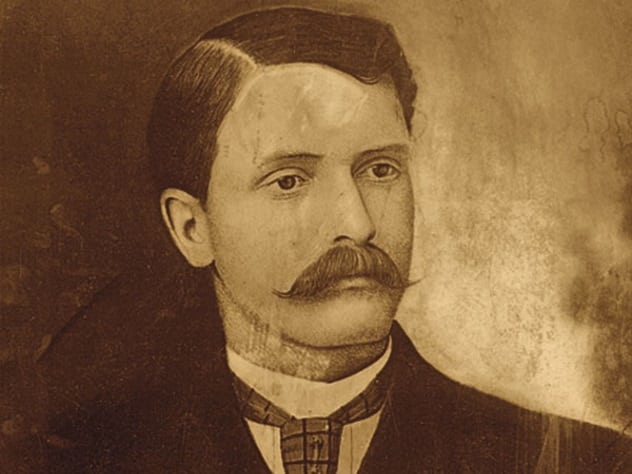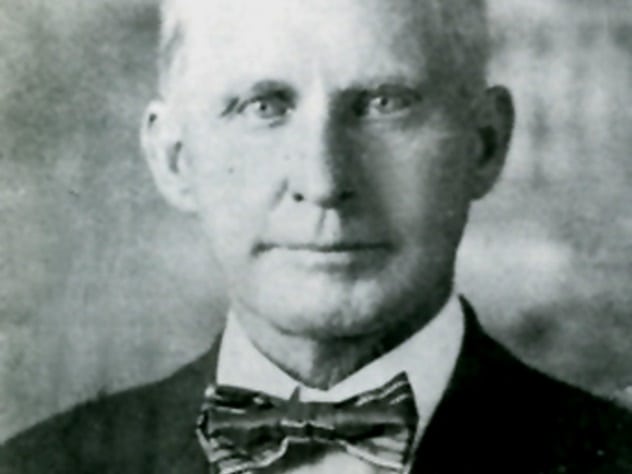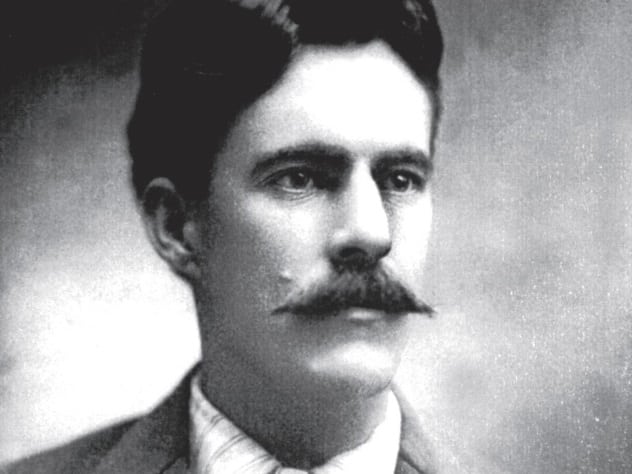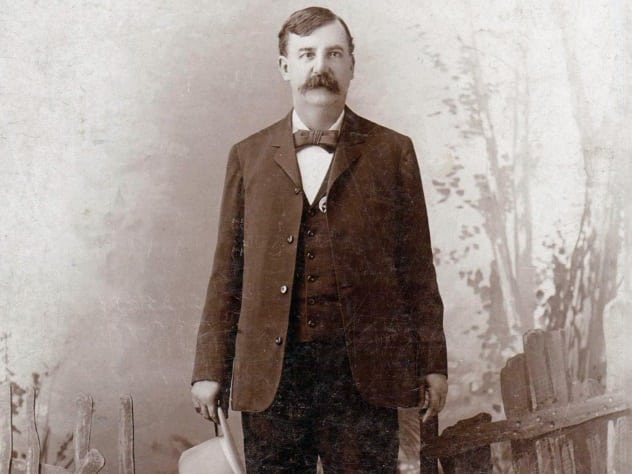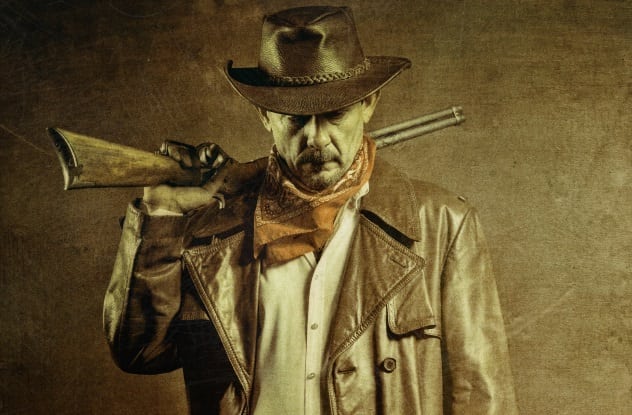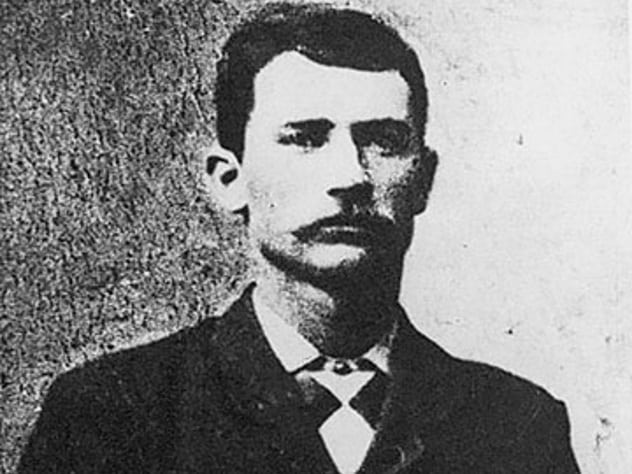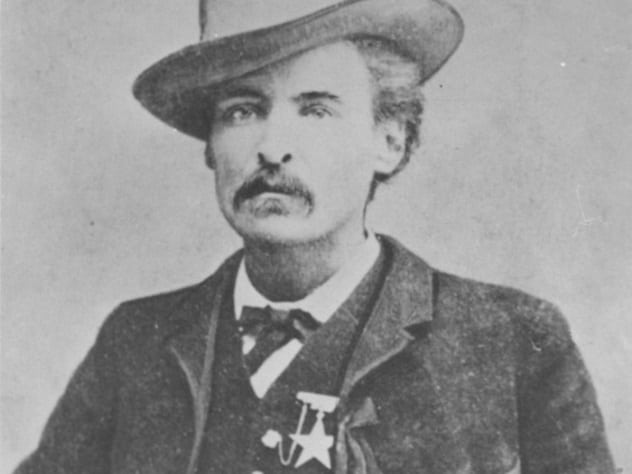There were, perhaps, a few upstanding citizen sheriffs in white hats, but not many made it to the history books—probably because they didn’t last very long. Those whose names are remembered today often weren’t entirely aboveboard. Here are ten lawmen who gave the outlaws as good as they got.
10 Bill Tilghman
Bill Tilghman was born in Iowa but moved to Kansas. When he was still a young man, Tilghman became a hunter, and he claimed to have killed 12,000 bison in only five years, much to the annoyance of the local Native Americans, for whom this meant food. During an exchange in September 1872, Tilghman is said to have killed seven Cheyenne braves. It wasn’t his only scrape with the law. Two years later, he just barely escaped being lynched after he was accused of murdering a man in Granada, Colorado.[1] In 1875, he opened a saloon in Dodge City, Kansas, and in 1878, he became the town’s deputy sheriff. He is said to have collected more rewards for bringing in outlaws than anyone else. During his time as sheriff, he was accused of corruption and selling whiskey to the Native Americans. He was also arrested several times for running a brothel and facilitating gambling. Tilgham was shot on November 1, 1924, while trying to arrest a corrupt Prohibition officer. Karma?
9 William Davis ‘Dave’ Allison
Dave Allison was appointed sheriff 1888 in Midland, Texas, at the tender age of 27. He remained as sheriff until 1903, when he joined the Arizona Rangers. In Arizona, he shot and killed a criminal with the wonderful name of “Three Fingered Jack” in a shoot-out. Allison is best known, however, for leading the posse that captured and killed the Mexican revolutionary-turned-outlaw Pascual Orozco in 1915. Allison is said to have been “the most noted gunman in Texas.” Allison was, however, also said to have a serious gambling problem, and there were several accusations made against him regarding the misappropriation of money. At these times, Allison moved swiftly to another position in another town, albeit always working as a lawman. This was, presumably, a “no references required” kind of job.[2] Allison, along with a colleague, was killed by a pair of cattle thieves whom they were preparing to testify against. They were sitting, unarmed, in the lobby of a hotel, when the gunmen burst in and shot them.
8 Harry Wheeler
Harry C. Wheeler had a variety of jobs before he was appointed the sheriff of Cochise County, Arizona, including, in 1907, protecting striking miners from thugs hired by their employers. He was considered a “friend of labor,” and his popularity in the town grew. However, ten years later, when he was sheriff, he deputized and armed 2,000 men and sent them out at dawn to arrest striking miners while he supervised the proceedings with a machine gun. In total 1,185 miners were arrested, loaded onto cattle trucks, and transported into the New Mexico desert, where they were abandoned. Wheeler was indicted, along with 224 of his deputies, on charges of kidnapping, though these were later dropped. One of Wheeler’s most notable exploits was a rock fight with a man who had been stalking an ex-girlfriend. Wheeler heard about the man’s threat to kill the girl and her new husband and went to arrest him. The stalker, J.A. Tracy, fired a shot which missed so narrowly that bullet went through Wheeler’s coat. Both men exchanged gunfire. Wheeler was shot in the thigh, while Tracy was shot four times. Feigning an empty gun, Tracy pretended to give himself up, and then shot at Wheeler twice more. However, he wasn’t a very good marksman and only ended up hitting Wheeler once in the foot. Being out of bullets himself, Wheeler resorted to heaving rocks at Tracy until the latter’s wounds overcame him. Astonishingly, Tracy was not arrested for his actions, and the two men shook hands before Wheeler put him on a train to Tuscon, which was unfortunate because Tracy was wanted for murder in Nevada. However, Tracy’s injuries were such that he died on the train. Wheeler collected the reward money, which was $500, but gave it to the widow of one of Tracy’s victims.[3]
7 Heck Thomas
Henry Andrew Thomas, commonly known as “Heck,” apprehended some of the most notorious outlaws of the Wild West, including members of the Dalton Gang and the Doolin Gang. He began his working life serving as a courier in the Civil War in Virginia when he was just 12 years old. He joined the police force at the age of 17 in Atlanta and soon began to make a name for himself as a fearless fighter. In 1875, he moved to Texas. In 1878, he was in charge of protecting the railroads when the Sam Bass Gang tried to rob a train. Thomas was injured during the shoot-out, but his quick thinking ensured that the gang got away with nothing; he had moved the valuables to an unlit stove and filled the safe with decoy parcels.[4] In 1896, Thomas led a posse that tracked down the Doolin Gang, which had been robbing trains and banks in Kansas. They caught the leader of the gang, Bill Doolin, after a long pursuit, fatally wounding Doolin after the robber tried to shoot his way out. Heck Thomas was responsible for arresting over 300 wanted men. He once collected 41 prisoners in a single episode. He was wounded at least six times during his gunfights but managed to live long enough to retire from the force.
6 John Reynolds Hughes
In May 1886, John Reynolds Hughes (seated on the right above) set out to discover who had stolen horses from his and his neighbors’ ranches. He trailed them for close to a year before coming upon them in New Mexico. He killed some of the horse thieves and captured the rest before returning the horses to his neighbors. The exploit earned the attention of the Texas Rangers, who persuaded him to join up. Hughes served as a Texas Ranger for 28 years. When his captain was killed by bandits in 1893, Hughes was named as his successor. His first act as captain was to take a group of his men to search the border until they found, and killed, all those responsible for the death.[5]
5 John Hicks Adams
John Hicks Adams was a bona fide forty-niner. In 1849, he left his home in Illinois for California as soon as news of the Gold Rush reached him and remained for two years until moving to Santa Clara County with his family to settle on a farm. He was elected sheriff in 1863 and was involved in the pursuit and capture of Tiburcio Vasquez, a notorious bandit and horse thief. His interest in gold never waned, and he is credited with making the first exploration of Lake Tahoe.[6] In 1878, Adams was killed in Arizona while prospecting for gold. The suspects escaped to Mexico and were never tried for his murder. However, they were all later killed by an unidentified posse.
4 John Armstrong
John Barclay Armstrong moved to Austin, Texas, in 1871. He joined the Texas Rangers in 1875 and took part in the Las Cuevas War. Armstrong was a member of Captain Leander McNelly’s Special Forces, which, like all special forces, operated on a “Shoot now; ask questions later” policy. Among his many exploits was his capture of John Wesley Hardin. Hardin, a notorious outlaw said to have once killed a man for snoring too loudly, was wanted for the murder of Deputy Sheriff Charles Webb. At the time, Armstrong was recovering from a gunshot wound and needed to walk with the aid of a cane, but he still volunteered to help track Hardin down. After receiving information as to Hardin’s whereabouts, Armstrong and his men went in pursuit. They tracked him onto a train in Florida, and as the train pulled into a station, Armstrong entered the coach. Seeing only a man with a cane, Hardin did not reach for the gun hanging from the luggage rack above his head, which was a mistake. Armstrong suddenly switched his cane to his left hand and drew his gun, confronting not only Hardin but also four members of his gang. One of the gang members opened fire, and Armstrong killed him instantly before hitting Hardin over the head and knocking him unconscious.[7]
3 Henry Newton Brown
Henry Newton Brown was a classic example of a poacher-turned-gamekeeper. He had once ridden with Billy the Kid, and they ambushed and murdered a sheriff in New Mexico in 1878. After making a hasty retreat, Brown disappeared for a while before reappearing in Texas, where he worked as a deputy sheriff for a short time. He became a ranch hand and ended up in Kansas, where he again took up law enforcement. In order to make ends meet, Brown began to track outlaws for their bounty, but occasionally, he got sidetracked. In April 1884, at the Medicine Lodge bank, Brown and three accomplices burst in just after opening time and robbed it, shooting several bank employees in the process.[8] They made their getaway but were soon surrounded. The locals were shocked when they discovered the identity of the thief, and there were many calls to hang Brown. He was due to hang in the morning, but the mob could not wait. They broke into the jail, overpowered the guards, and opened the cell. Brown, as was his nature, made a desperate attempt to escape, but he was shot dead.
2 Frank M. Canton
Frank Canton was jailed in 1877, under his birth name of Josiah Horner, for robbing a bank in Comanche, Texas, but soon escaped and signed on as a cattle herder, working his way to Nebraska. Deciding on a new start, he changed his name to Frank M. Canton and settled into a job protecting cattle stock for a large consortium of Wyoming cattlemen with questionable ethics. In 1882, he was elected sheriff of Johnson County, Wyoming. During the Johnson County War, Canton signed on as one of Frank Wolcott’s Regulators. In April 1892, he led the Regulators to the KC Ranch, where Nate Champion and Nick Ray, small-time ranchers who had been falsely accused of cattle rustling, were holed up. Champion had been a friend of Canton’s, but this did not prevent Canton from setting the house on fire after a gun battle that had lasted most of the day. As the house burned around him, Champion burst out of the house and was shot 28 times. Canton left town shortly after and traveled to Oklahoma, where he became a deputy US marshal. He killed the fugitive Bill Dunn in 1896. In 1897, he left for Alaska due to a gold rush. He returned to Oklahoma the next year and continued to work in law enforcement.[9]
1 ‘Longhair Jim’ Courtright
In addition to his untamed locks, Timothy Isaiah “Longhair Jim” Courtright was known for his skill as a gunman, performing at one time as part of Buffalo Bill’s Wild West Show. Always a controversial character, he was the first elected marshal of Fort Worth, Texas. He also ran protection rackets in the local saloons and gambling houses. He is rumored to have killed several business owners who declined his offers of protection. His enthusiasm for his work often ran away with him. At one point, he was employed to track down cattle rustlers, but he ended up killing both rustlers and homesteaders. Courtright finally met his end in 1887 in a duel with Luke Short, a saloon owner and former friend of Courtright’s. Short had told Courtright to “go to hell” when the former had offered the latter protection. In the middle of the street, the two men met in one of the very few face-to-face gunfights to have actually taken place in the Wild West. After a tense standoff, both men drew their pistols at the same time. Short fired first, blowing off Courtright’s thumb. Courtright tried to shift his gun to his uninjured hand, but as he did so, Short shot him in the chest.[10] Ward Hazell is a writer who travels, and an occasional travel writer.
